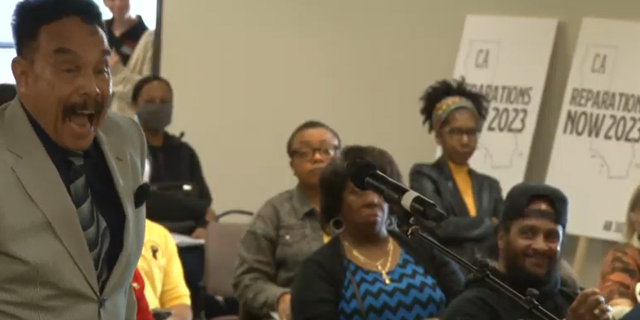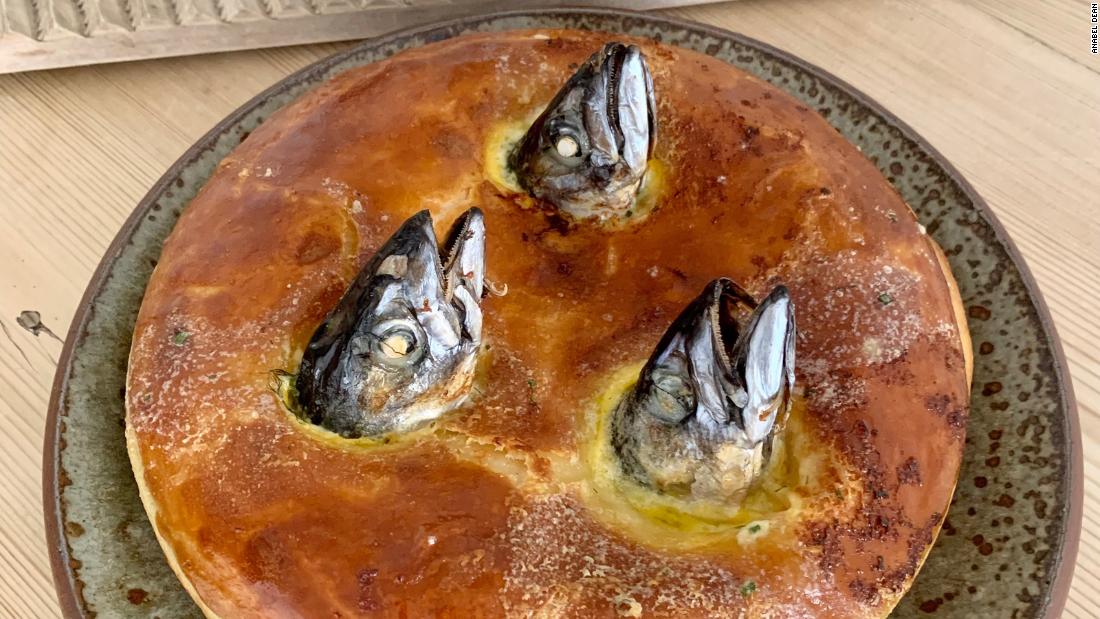In Claughton, Lancashire, the Forterra brickworks produces 50 million bricks a year, from shale that’s quarried a mile and a half …
Category: All
Activist at California slavery reparations meeting denounces proposed payment of $223,000: 'Not enough!'
California’s reparations task force met again on Friday in San Diego with public comment from speakers who urged bold action and for the state to go forward with payments to African Americans as repayment for slavery. After comments by Dr. Shirley Weber, California Secretary of State, one speaker blasted the suggested amount of $223,000 per resident as insufficient.
Reverend Tony Pierce came to the microphone and slammed the idea of limiting the cash payouts to California residents: “There should be no residency requirements for California! We have to encourage our people to come back to California! What better way to encourage our people to come back to California if we have no requirements?”
“How will reparations be paid?” he added. “Immediately!”
After being told that his time is up, Pierce yelled at the audience, “And $200,000 is not enough! $223,000 is not enough!”
BLACK REPARATIONS PANEL COULD DECIDE WHO GETS COMPENSATION

California had a public comment period on January 27, 2023 for its reparations task force.
(screenshot/YouTube)
In December, one attendee at the task force meeting called for $350,000 per eligible individual.
California resident and Civil Justice Association of California member Marcus Champion called for “direct cash payments, tax-exempt status, free college education, grants for homeownership, business grants, access to low to no business funding and capital.” He called for the creation of The Office of American Freedmen Affairs to handle eligibility on reparations.
Speaker Josiah Williams, a member of American Redress Coalition of the California Bay Area, called for a specific targeting of the reparations claims.
“I wanted to add that if there is anyone else who has their own claim, they can definitely write it up, get someone to champion it and I would support them in that effort,” he said. “But this is for a specific group of people.”
CALIFORNIA IS TOO BROKE TO GIVE REPARATIONS: VICTOR DAVIS HANSON

FILE – In this June 11, 2020, file photo, then-Assemblywoman Shirley Weber, D-San Diego, wears a face mask as she calls on lawmakers to create a task force to study and develop reparation proposals for African Americans, during the Assembly session in Sacramento, Calif. (AP Photo/Rich Pedroncelli, File)
California Secretary of State Weber opened the comment period to the public by imploring action on reparations.
“I want to make sure that the work gets done and the work continues. San Diego has turned out because they want to know what you’re going to do,” she said. “They want to impact it, and they are strong supporters of reparations. And we will need every supporter in California and beyond to pull this off.”
California was admitted to the union on September 9, 1850 as a free state.
According to the State of California’s Department of Justice website, the bill AB 3121 “charges the Reparations Task Force with studying the institution of slavery and its lingering negative effects on living African Americans, including descendants of persons enslaved in the United States and on society.”

St. Paul, Minnesota. June 17, 20201. March and rally for reparations, child protection and advancement of peoples rights. (Photo by: Michael Siluk/UCG/Universal Images Group via Getty Images)
((Photo by: Michael Siluk/UCG/Universal Images Group via Getty Images))
The website also cautions anyone expecting quick action in 2023, saying, “Under AB 3121, any reparations program will need to be enacted by the Legislature and approved by the Governor. The Reparations Task Force’s role is to develop recommendations for future Legislative action. Therefore, at this time, there is no claims process.”
CLICK HERE TO GET THE FOX NEWS APP
The New York Post reported on January 16 that San Francisco was considering a “one-time payment of $5 million to each Black resident of the city deemed eligible as recompense for the “decades of harm they have experienced.”
Meanwhile, the California Reparations Task Force has a July 1, 2023 deadline to report to the state legislature with recommendations.
Aryna Sabalenka defeats Elena Rybakina to win thrilling women's Australian Open final
CNN
—
Belarusian-born Aryna Sabalenka defeated Elena Rybakina in three sets to win a thrilling women’s Australian Open final Saturday, becoming the first player competing under a neutral flag to secure a grand slam.
Amid the ongoing conflict in Ukraine, tournament organizer Tennis Australia required Russian and Belarusian players to compete as neutrals.
Outplayed in the opening set, Sabalenka came from behind to overpower the reigning Wimbledon champion 4-6 6-3 6-4 in a remarkable turnaround in Melbourne.
Breaking Rybakina’s serve in the seventh game of a tense third set proved to be the crucial breakthrough for the fifth seed, whose venomous serve and intense groundstrokes ultimately paved the way for her success.
A nervous start from Sabalenka – she made five double faults and won only four points on the second serve in the first set – made it seem as if it would be a routine second grand slam for Rybakina as she secured the first set in 34 minutes.
But Sabalenka found accuracy as well as power in the second and third sets, with Rybakina faltering at crucial stages. The Russian-born Kazakh, who is also a big hitter, saw off three championship points but sent a forehand long on the fourth. Sabalenka fell to the ground, reduced to tears on wining her maiden major.

She celebrated by climbing to the players’ box where her coach, Anton Dubrov, could be seen sobbing into a towel.
“I’m still shaking and super nervous,” she told the spectators in her on-court speech before the presentation.
On receiving the trophy from Billie Jean King, Sabalenka thanked the American great for her pioneering work for the women’s game, and went on to thank her team, whom she described as the “craziest on tour.”
“We’ve been through a lot of downs last year,” she said. “We worked so hard, you guys deserve this trophy, it’s more about you than about me. Thank you so much for everything you do for me. I love you.”

Minsk-born Sabalenka was competing in her first grand slam final, having previously lost three major semifinals. Serving first, she opened the match with a double fault as nerves clearly played a part on an occasion such as this. She later admitted that she tactically didn’t “play my best” in the first set.
In the second set she targeted the Rybakina forehand and broke early for a 3-1 lead. When Rybakina threatened to break back immediately, as she had done in the first set, Sabalenka held firm, overcoming another double fault to further extend her lead at 4-1 before going on to clinch the set with an ace.
After an impressive second set from Sabalenka, the match entered a tense third set decider. Initially the pair went toe-to-toe, both having the bravery to go for their shots, to maintain the power, but it was Sabalenka who eventually broke through, ending an entertaining final with 17 aces and 51 winners.
“I need a few more days to realize what happened,” Sabalenka told Eurosport.
“I’m just super happy and proud. There’s so many things in my head. I’m not on this planet right now. It’s kind of relief, I’ve been in the top 10 but I didn’t have a grand slam trophy yet and it’s been really tough to get it, every slam was super emotional.
“It’s relief, it’s a joy, I’m just proud of myself, of everyone.”
Asked how she would celebrate, Sabalenka said, laughing: “Probably eating everything that I couldn’t this week.”

Rybakina was ranked 25th in the world coming into this tournament – a position which belies her talent and success – and she began the tournament playing on the outside courts.
Her failure to break into the top 10 stemmed mainly from the fact that ranking points from last year’s Wimbledon were removed because of the tournament’s decision to ban Russians and Belarusians from playing.
Reaching the final in Melbourne – where she defeated three former grand slam winners along the way in Iga Światek, Jelena Ostapenko and Victoria Azarenka – will no doubt help her rise up the rankings.
“Hopefully we are going to have many more battles,” Rybakina told Sabalenka during the trophy presentation. “It was a good year for me and hopefully next year I am going to have the same result and (do) even better.”
To avoid cheating, take your partner’s perspective
Perspective-taking—or putting yourself in our partner’s shoes—reduces the temptation to cheat, research finds.
It also inoculates against other partnership-destroying behaviors, according to the study in the Journal of Sex Research on the findings from three double-blind, randomized experiments.
People cheat for a variety of reasons, according to lead author Gurit Birnbaum, a professor of psychology at Reichman University’s Ivcher School of Psychology in Israel. Birnbaum notes that while people may be satisfied with their relationships, they may still betray their partners. For example, so-called “avoidant types” who feel uncomfortable with intimacy may try to maintain distance and control in their relationship by cheating.
Context is key.
“People often cheat not because they planned to do so,” Birnbaum says. “Rather, the opportunity presented itself and they were too depleted—too tired, too drunk, too distracted—to fight the temptation.”
Coauthor Harry Reis, a professor at the University of Rochester, agrees that there are multiple reasons for cheating. One of the more interesting ones, says Reis, author of Relationships, Well-Being and Behaviour (Routledge, 2018), is that men are more likely to cheat because they feel that their sexual needs are not being met. The evidence has shown that women, on the other hand, are more likely to cheat because they feel that their emotional needs aren’t met.
Across three studies, the 408 total participants (213 Israeli women and 195 Israeli men, ranging in age from 20 to 47) were randomly assigned to either adopt the perspective of their partner or not. The participants were uniformly in monogamous, mixed-sex relationships of at least four months. As part of the experiments, the participants evaluated, encountered, or thought about attractive strangers while the psychologists recorded their expressions of interest in these strangers, as well as their commitment to and desire for their current partners.
The researchers found that adopting a partner’s perspective increased commitment and desire for the partner, while simultaneously decreasing sexual and romantic interest in alternative mates. The findings suggest that perspective taking discourages people from engaging in behaviors that may hurt their partners and damage their relationship.
“Both partners may feel more satisfied with their relationship,” says Birnbaum, “and therefore might be less likely to cheat on each other, even if only one of them adopts this strategy.”
“Perspective taking doesn’t prevent you from cheating, but it lessens the desire to do so,” says Reis. Ultimately, he says, cheating means “prioritizing one’s own goals over the good of the partner and the relationship, so seeing things from the other person’s perspective gives one a more balanced view of these situations.”
According to Birnbaum, the findings can help people understand how to resist short-term temptations: “Active consideration of how romantic partners may be affected by these situations serves as a strategy that encourages people to control their responses to attractive alternative partners and derogate their attractiveness.”
The team did not test if the benefits of perspective taking extended to the participants’ romantic partners who were not part of the experiment. But the researchers have a hunch, because perspective taking generally promotes empathy, understanding, closeness, and caring.
“Both partners may feel more satisfied with their relationship,” says Birnbaum, “and therefore might be less likely to cheat on each other, even if only one of them adopts this strategy.”
Besides reducing the likelihood of infidelity, perspective taking motivates people to have compassion for their partners’ emotions and to seek to strengthen the bond with that partner, thereby boosting the existing relationship.
“People invariably feel better understood, and that makes it easier to resolve disagreements, to be appropriately but not intrusively helpful, and to share joys and accomplishments,” Reis says. “It’s one of those skills that can help people see the ‘us’—rather than the ‘me and you’—in a relationship.”
The research had support from the Israel Science Foundation and the Binational Science Foundation.
Source: University of Rochester
Karine Jean-Pierre upstaged by White House official in Biden docs saga, critics say: 'She talks like a binder'
Retired Rear Adm. John Kirby’s willingness to engage with the press about President Biden’s classified documents saga amid perceived stonewalling by White House Press Secretary Karine Jean-Pierre shows she may not be fit for her job, critics said Friday.
Kirby, who served as Pentagon spokesman under former President Barack Obama and briefly under Biden, is currently the National Security Council’s coordinator for strategic communications. He often engages with the press on matters like Ukraine, Russia and China.
Kirby joined Jean-Pierre for a briefing earlier this month, and took questions from reporters including Fox News’ Peter Doocy. On “The Five,” host Jesse Watters quipped that Jean-Pierre “talks like a binder” and has repeated the same canned lines and purported deflections over and over.
“I’m sorry, I’m going to have to refer you to the White House counsel,” he replied in jest to co-host Brian Kilmeade after being asked about Kirby’s receptiveness questions about Biden’s classified documents scandal.
“You can only use that line in special moments. That can’t be your answer for every single question. And that’s why Kirby is quality,” Watters added.
PENCE SPEAKS OUT FOR FIRST TIME AFTER CLASSIFIED DOCS FOUND IN INDIANA HOME

White House Press Secretary Karine Jean-Pierre and John Kirby arrive at a White House daily news briefing at the James S. Brady Press Briefing Room.
(Alex Wong/Getty Images)
Kilmeade pointed to an exchange between Doocy and Jean-Pierre in which the correspondent referenced something Kirby had stated at a prior briefing about the Biden documents situation, to which the press secretary questioned where Doocy had heard the statement.
When Doocy indicated the source was Kirby, Jean-Pierre referred him to the White House counsel’s office for any further clarification.
“Kirby has the wherewithal to be able to dance and dip appropriately and talk like a human being,” Watters said. “[Jean-Pierre] can’t talk like a human being. She talks like a binder.”
MORE CLASSIFIED DOCUMENTS FOUND IN BIDEN’S DELAWARE GARAGE, WHITE HOUSE REVEALS

Then-Pentagon Press Secretary John Kirby holds a news briefing
(Kevin Dietsch/Getty Images)
The “Jesse Watters Primetime” host added he believes Jean-Pierre’s job performance could lead to her departure from the White House in the coming months.
He also referenced how first lady Jill Biden appeared to block her husband from a reporter’s shouted question about the classified material saga at a recent White House event.
“[M]an, does Joe need a lot of help,” he quipped.
Judge Jeanine Pirro added Jeani-Pierre is either “complicit in blocking the information” from the public or simply “inaccurate” in her position presidential attorneys must field such a proportion of the press’ questions.
“[D]uring the Russia collusion investigation, they answered [questions] all the time,” she later added in-part.
“But the most important thing is their own self-esteem. I mean, how does the woman go out there? Did she not know how embarrassing it is, how she looks ridiculous?”
Mo Salah 'suffering' due to inconsistent Liverpool attack, says Jurgen Klopp
CNN
—
Mo Salah was Liverpool’s figurehead, his goalscoring prowess the capstone of a team accustomed to winning trophies.
But, like the rest of his team, Salah is “suffering” this season because of the constant disruption to Liverpool’s attack, scoring just once in his last six appearances, manager Jurgen Klopp said in a press conference on Friday.
Injuries to key players – Salah has played just 343 minutes alongside likely fellow starters Luis Diaz and Darwin Núñez – have only heightened the loss of Sadio Mané to Bayern Munich last season, breaking up Liverpool’s cohesive offensive unit.
“It was a well-drilled machine the front three; everything was clear what we were doing,” Klopp said. “Everyone suffers, that’s clear. It is specific, offensive play that requires a lot of work and a lot of information, and not always obvious information.”
This season, Salah has scored seven goals in 19 Premier League games, unlike in 2021/22 when he contributed 23 goals and won the Golden Boot.
Lying in ninth in the Premier League having scored fewer goals, conceded more, and won fewer points than any of the previous seven seasons at this stage under Klopp’s tenure, Liverpool’s problems run deeper than just Salah’s misfiring form.
“Mo has scored hundreds of goals in recent years and when you don’t score the first thing people think about is that, but that is not our problem at the moment,” Klopp added.
“We started the season with Harvey [Elliott] in the half position, with Hendo [Jordan Henderson] it is different, and now it is Naby [Keïta]. So things are different all the time but usually you have a real basis to build on and that is what we don’t have.”

As Klopp seeks to kickstart Liverpool’s floundering season, he hopes that January signing Cody Gakpo can offer an alternative offensive option.
“Now we have Cody [Gakpo], obviously a really important asset, a connector; he can play the wing and the centre as well,” Klopp said.
Liverpool next take to the field against Brighton in the FA Cup fourth round on Sunday.
Was CO2 actually lower before Earth got trees?
Geochemical evidence suggests that carbon dioxide levels may have been much lower millions of years before the emergence of large forests.
Over 400 million years ago, primitive shrub-like plants covered Earth’s continents. It was during the Devonian period, around 385 million years ago, when shrubs evolved into small trees and forests emerged.
From providing wildlife habitat to reducing erosion and absorbing CO2 from the air, trees play an important role in maintaining a livable environment. So before trees, you might think CO2 levels were higher, right?
The new findings, published in Nature Communications, run contrary to that assumption and previous estimates.
Christopher Junium, associate professor of earth and environmental sciences at Syracuse University and his collaborators, including the study’s lead author Tais W. Dahl, associate professor from the Globe Institute at the University of Copenhagen, found that the earliest vascular plants substantially reduced CO2 levels long before the evolution of forests. This early CO2 decline may have led to significant global cooling and glaciation during this period.
The team analyzed modern descendants of club mosses, plant fossils, and geochemical data and found that 410–380 million years ago, CO2 levels were only modestly elevated compared to the present day—about 1.5 times greater than current levels, compared to up to 10 times greater, as previously estimated.
Using paleoclimate and earth systems modeling, they found that CO2 decline and simultaneous oxygen (O2) increase, even by the earliest land plants, was enough to have led to significant climatic cooling and partial glaciation, consistent with geological evidence.
Junium’s work on the project involved analyzing Early Devonian Period fossil plant materials for their carbon stable isotope composition. By comparing ratios of carbon, researchers can determine how plants incorporated carbon dioxide from the atmosphere into their tissues during photosynthesis.
“The specific values (of carbon isotopes) can help us determine the concentration of carbon dioxide in the atmosphere,” says Junium, who conducted the research in his lab using an isotope-ratio mass spectrometer, which has been custom modified to allow for analysis of extremely precise nanomolar quantities of fossil carbon.
“The 410- to 380-million-year-old plant materials we analyzed were some of the oldest fossil vascular plants that colonized land before the rise of large forests. The analyses revealed that the ancient plant materials had carbon isotope compositions that were surprisingly similar to modern plants and suggested that the concentration of carbon dioxide in the Early Devonian was not as high as we had thought.”
The new analyses served as a starting point for a deep reexamination of the evidence for high carbon dioxide concentrations prior to the expansion of large forests.
“A new method has enabled us to calculate the CO2 level in the atmosphere in the past based on plant fossils,” writes Dahl. “We initially applied the method to the time before forests emerged—a time which researchers agreed was characterized by high levels of CO2 in the atmosphere. We used to think that the emergence of forests reduced the amount of atmospheric CO2 on Earth. But instead of 4,000 parts per million (ppm), which is the amount researchers assumed was found on the planet back then, we have shown that the figure is close to 600 ppm, which is not far from the level we are approaching today.”
The team ultimately found that the emergence of large forests later in the Devonian may not have played as important of a role in decreasing carbon dioxide as previously thought, despite the fact that evidence suggests that the climate cooled considerably from the Early to the Late Devonian.
“The growth of smaller plants like those we analyzed appear to have induced changes in the terrestrial biosphere sufficient to decrease carbon dioxide and increase oxygen through the growth of soils and weathering of nutrient-rich rocks,” says Junium.
In terms of the study’s impact for the future of climate change, it underscores the growing consensus that Earth’s climate is highly sensitive to CO2 levels and that efforts to limit further CO2 increase can only improve the future outlook.
“Just because our results suggest that expansion of forests in the Devonian did not cause a dramatic decrease in carbon dioxide does not mean that afforestation—planting new forests on land without trees—is something we should not do,” says Junium. “Rather, climate mitigation practices need to involve decreasing emissions and multiple means for removing CO2 from the atmosphere. Planting trees and evaluating ways to increase weathering will be important tools for long-term carbon dioxide reduction and stabilization.”
Dahl adds, “To understand how this works on a global scale, and what the consequences are, it is a good idea to look at what happened in the past when the Earth saw major changes and these mechanisms changed. And that is what this study does.”
Source: Syracuse University
Animal shelter reunites dog with owner who abandoned her due to homelessness: 'Incredible update'
A Tennessee animal shelter says it has successfully reunited a homeless woman with her dog after the woman was forced to abandon the animal because she could no longer afford to take care of it.
The McKamey Animal Center posted on Facebook Wednesday about an “incredible update” when a dog named Lilo was reunited with an owner who had previously abandoned the pet along with a heartfelt note apologizing for no longer being able to take care of the animal due to financial hardship and homelessness.
“While we can’t share a lot of the details with you yet, we are actively working with the family to set them up with a safe haven, shelter, and resources to stay together and tackle homelessness,” the post said, along with a photo of a woman hugging Lilo.
The update follows a previous Facebook post when the animal center said that Lilo was found by a good Samaritan walking around with her leash still attached.
LOUISIANA DOG HAILED A HERO FOR PROTECTING YOUNG GIRLS LOST IN WOODS FOR HOURS

A dog named Lilo was reunited with her owner who was forced to give her up due to homelessness.
(McKamey Animal Center)
“We are so sorry that you had to make the decision to leave her behind,” the shelter said to the unknown owner in the Facebook post. “We know many folks are struggling to care for their pets right now. We know how hard it must be to give up an animal you so clearly loved because you can’t provide the care she needs. We understand.”
The Facebook post included a note that had been left by the owner explaining why she could no longer take care of her pet dog.
VEGAS POLICE INVESTIGATING AFTER DOG FOUND SHOT MULTIPLE TIMES AND WITH FRACTURED SKULL

A note written by the owner of a dog abandoned due to financial hardship.
(McKamey Animal Center)
“My name is Lilo,” the note said. “Please love me. My mom can’t keep me and is homeless with two kids. She tried her best but she can’t get help. I cost too much for her. She really loves me and I’m a great dog and love to be loved on. Please don’t abuse me.”
In the Facebook post, the Chattanooga shelter assured the owner that Lilo is safe and that they will “take the very best care of her.”
MARYLAND POSTAL WORKER HAILED AS ‘HERO’ FOR SAVING DOGS FROM BURNING HOUSE: ‘DEAD WITHOUT YOU’

A dog named Lilo was reunited with its owner who was forced to give her up due to homelessness.
(McKamey Animal Center)
“But if you are reading this, we hope you will come forward to reclaim her,” the post said. “We will help you with whatever you need to care for her, to the best of our ability.”
“Lilo definitely misses you, and we would like nothing more than to see her go back to the family she loves. Either way, please know that we understand, we will not judge, and we are here to help in any way we can.”
In a statement to Fox News Digital, a shelter representative said that it’s important for the public to avoid stigmatizing the homeless population.
“I just want people to know and understand that homelessness comes with lots of stigma and assumptions – it can happen to anyone,” McKamey Animal Center Director of Advancement Lauren D. Mann said.
“Folks should be kind to everyone they meet and if they are struggling with caring for their pet(s), to reach out to their local animal shelter. Shelters across the country have resources, pantries, etc. and are happy to help people.”
Controversial cuisine: Fish head pie and 'devil's dung'
(CNN) — This week in travel news, we bring you fish head pie, “devil’s dung,” mummified crocodiles and a cane toad named Toadzilla. Also, we want to hear your craziest, wildest travel stories.
Tell us your hair-raising adventures
We want to hear your most hair-raising travel stories with a happy ending, where you lived to tell the tale and now have a blockbuster yarn. Send us a short summary by email, and we could be in touch to turn it into a CNN story to share with the world ([email protected]).
Cutting-edge cuisine
Wild world
A wave of extreme cold has spread through northeast Asia, with parts of Japan and South Korea seeing heavy snow and record-breaking subzero temperatures during the Lunar New Year holiday. CNN’s Paula Hancocks has more.
Egyptian treasures
European islands where you can escape the world
Bring Your Own Bottle
In case you missed it
Disney’s Splash Mountain fans are grabbing up all the souvenirs they can.
There’s an Alpine hotel with an international border running through its rooms.
Top image: Cornish delicacy Stargazy Pie (Anabel Dean).
West Antarctica Ice Sheet collapse isn’t set in stone
The pace and extent of ice destabilization along West Antarctica’s coast varies according to differences in regional climate, according to a new study.
The researchers combined satellite imagery and climate and ocean records to obtain the most detailed understanding yet of how the West Antarctic Ice Sheet—which contains enough ice to raise global sea level by 11 feet, or 3.3 meters—is responding to climate change.
The findings in Nature Communications show that while the West Antarctic Ice Sheet continues to retreat, the pace of retreat slowed in a key region between 2003 and 2015, driven by ocean temperatures, which were in turn caused by variations in offshore winds.

The marine-based West Antarctic Ice Sheet, home to the vast and unstable Pine Island and Thwaites glaciers, sits on an underwater landmass peaking 1.5 miles, or 2.5 kilometers, below the ocean’s surface.
Since the early 1990s, scientists have observed an abrupt acceleration in ice melt, retreat, and speed in this area, which is attributed in part to human-induced climate change over the past century.
Previous studies indicated that the observed changes could be the onset of an irreversible, ice-sheet-wide collapse, which would continue independently of any further climate-driven influence.
“The idea that once a marine-based ice sheet passes a certain tipping point it will cause a runaway response has been widely reported,” says lead author Frazer Christie at Cambridge University. “Despite this, questions remain about the extent to which ongoing changes in climate still regulate ice losses along the entire West Antarctic coastline.”
Using observations collected by an array of satellites, the new study found pronounced regional variations in how the West Antarctic Ice Sheet has changed since 2003 due to climate change, with the pace of retreat in the Amundsen Sea Sector, an area of West Antarctica facing the Pacific Ocean, having slowed significantly. That’s in contrast to the neighboring Bellingshausen Sea Sector, closer to the tip of the Antarctic Peninsula, where glacier retreat accelerated during that time.
By analyzing climate and ocean records, the researchers linked these regional differences to changes in the strength and direction of offshore surface winds. When the prevailing westerly winds are stronger, more of the deeper, warmer ocean water reaches the surface and increases the rate of ice melt.
Researchers found that winds near the Amundsen Sector slackened between 2003 and 2015, because of a deepening of the Amundsen Sea low pressure system. This system is the key atmospheric circulation pattern in the region, and its center—near which changes in offshore wind strength are greatest—typically sits offshore of its namesake coast for most of the year.
The researchers found that the accelerated response of the glaciers flowing from the Bellingshausen Sea Sector can be explained by more constant winds there, causing more persistent ocean-driven melt.
Ultimately, the study illustrates the complexity of the competing ice, ocean, and atmosphere interactions driving shorter-term changes across West Antarctica, and raises important questions about how quickly the icy continent will evolve in a warming world.
“Ocean and atmospheric forcing mechanisms still really, really matter in West Antarctica,” says coauthor Eric Steig, a professor of earth and space sciences at the University of Washington. “That means that ice-sheet collapse is not inevitable. It depends on how climate changes over the next few decades, which we could influence in a positive way by reducing greenhouse gas emissions.”
And while the strength of the low-pressure cell in the Amundsen Sea is not necessarily tied to levels of greenhouse gases—itself an active area of study—the system’s influence shows that even the West Antarctic ice sheet is sensitive to weather and climate shifts.
Results show that changes in ocean, driven by changes in the winds, can slow down and even reverse the loss of ice, Steig says. But he points out that the effect is local and unlikely to last for more than a few decades.
“Only the most aggressive reductions in greenhouse gas emissions can plausibly turn the situation around in the long term,” Steig says.
Additional coauthors are from the University of Edinburgh. Support for the study came from the Carnegie Trust for the Universities of Scotland; the Scottish Alliance for Geoscience, Environment and Society; the Prince Albert II of Monaco Foundation; the UK Natural Environment Research Council; the US National Science Foundation; the joint UK/US International Thwaites Glacier Collaboration project; and the European Space Agency.
Source: University of Washington










